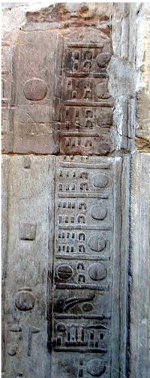The Ancient Egyptian calendar was originally based on twelve lunar months, grouped into three seasons of four months each. This was not ideal, as the lunar month is only twenty-nine and a half days long, and so some years would actually contain thirteen new moons.

The New Year was timed to coincide with the annual rising of the waters of the Nile. However, the actual date of the inundation could vary by as much as eighty days, making it a very inaccurate marker for the beginning of the year. Luckily, the ancient Egyptians had noticed that the star Sirius (which was the brightest star in the sky), reappeared in the sky after an absence of seventy days and heralded the rising of the Nile. So they adopted this far more reliable date as the marker of their new year.
The New Year officially began on the first new moon after the rising of Sirius. It is interesting to note the connection between the seventy day absence of Sirius before the inundation and New Year and the seventy day mummification ritual which ended with the rebirth of the deceased in the afterworld.
The calendar was not very accurate, but could be set back into alignment every New Year’s day. While this was sufficient to manage the planting of crops and time the preparations for the inundation, it was not accurate enough to support a complex administration and easy calculation and collection of taxation. As a result, a new civic calendar was developed during the Early Dynastic Period based around three seasons of four thirty day months each divided into three “decades” (sets of ten days). The two calendars ran concurrently and were used for different functions.

Yet, this only amounted to a three hundred and sixty day year, so five epagomenal days (known as “heriu renpet”) were added to the end of each year and dedicated to the five children of Nut (Osiris, Horus the Elder, Set, Isis and Nephthys). This system still missed a quarter of a day each year, causing the calendar to slip slowly out of position. Ptolemy III tried to introduce an extra day every four years to correct this, but the Egyptians were resistant to this idea and it was not fully implemented until Augustus introduced the “leap year” in 30BC.
Despite their use of this apparently confusing system, the Ancient Egyptians were such accomplished astronomers and mathematicians that they constructed Abu Simbel so precisely that a ray of sunshine extended down an internal corridor to illuminate a statue of the pharaoh on his birthday!
Seasons and Months
Akhet (inundation)

Tekh (Thoth)

Menhet (Phaophi)

Hwt-Hrw (Athyr)

Ka-Hr-Ka (Khoiak)

Peret (growth)

Sf-Bdt (Tybi)

Rekh Wer (Mekhir)

Rekh Neds (Phamenoth)

Renwet (Pharmuthi)

Shemu (harvest)

Hnsw (Pakhon)

Hnt-Htj (Payni)

Ipt-Hmt (Epiph)

Wep-Renpet (Mesore)
